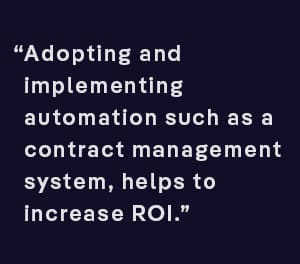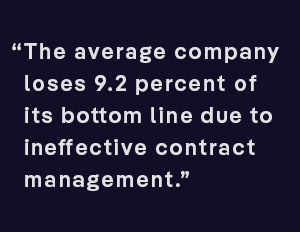What is Contract Management ROI?
Simply stated, ROI is the return on a given investment, in relation to the overall cost of that initial investment. To determine contract management ROI, in particular, corporate legal teams, contract managers, and contract administration professionals need to look at many factors, such as contracting efficiency and effectiveness. In other words, what optimal contract management achieves for your organization and what value contracts bring to your business.
When it comes to increasing contract management ROI, corporate legal teams, contract managers, and contract administration professionals put considerable time and effort into adopting and implementing contract management systems (CMS) — those that can also demonstrate that ROI senior leadership expects to see nowadays. This is partly in an effort to gain even more technological resources and improve contract management processes further.
How is Contract Management ROI Calculated?
Calculating ROI essentially means gauging an investment’s total profitability. It is figured out by dividing the profit earned on an investment by the cost of the investment. The following is a question that every general counsel (GC), let alone a chief financial officer (CFO), should ask themselves: if an average company nets about $100 to $200 million of bottom-line revenue (more on that below), just how much does it pay off to purchase and employ legal technology in the form of a contract management system.
First, consider research from World Commerce & Contracting (formerly the International Association for Contract & Commercial Management). World CC found that the average company loses 9.2 percent of its bottom line due to ineffective contract management. For a company generating $1 billion in revenue every year, estimate that roughly 10 to 20 percent of the top-line revenue will convert to the bottom line. That is because the average company will more than likely net about $100 to $200 million of bottom-line revenue.
Now, think about World CC’s finding again. If 9.2 percent of a company’s bottom line revenue is lost due to poor contract management, this amounts to approximately $9.2 to $18.4 million. However, a GC or CFO can bring up to $18.4 million to the bottom line simply by deploying an effective, end-to-end contract lifecycle management (CLM) system, for instance. That is the same as $92 to $184 million in top-line — or gross — revenue.
Finally, consider the fact that a reasonable contract management solution like a CLM system costs organizations about $100,000 in annual fees. The bottom-line ROI here, then, is the net at-risk revenue saved by using the CLM system, itself, divided by the annual cost of the solution (Or $9.1 to $18.3 million divided by $100,000.) That is a bottom-line ROI of about 91 to 183 times the costs.
In other words, for every single dollar invested in a CLM technology, you can expect to generate anywhere between $91 to $183 in recovered net revenue. Essentially, no revenue will get lost as a result of poor contract management practices. (And this math is done without an ROI calculator. It is a back-of-the-envelope calculation and, therefore, a rather conservative ROI estimate.) So, with this kind of contract management ROI, acquiring a CLM system hardly seems like a costly investment.
To calculate the CLM ROI for your own organization, try using ContractPodAi’s handy ROI calculator!
4 Strategies for Improving Contract Management ROI
To increase your organization’s contract management ROI, it is first important to review typical contracting metrics, such as:
- The amount of time your legal department spends managing and reviewing contracts
- The number of contracts across the entire organization
- The average value and the total value of all contract types
- The number of expired contracts and contracts that need to be renewed
- The locations where contracts are stored
Now, here are four key strategies to increase contract management ROI:
Create KPIs
At the core of the most effective contract management is the increase in productivity, the improvement of visibility, and the reduction of risk. And clearly, the key to measuring the success of any contract management program is identifying contract management key performance indicators (KPIs) in the first place.
Naturally, these KPIs will vary given that contracts, processes, organizations, and industries are fairly unique. Accordingly, it is necessary to review an organization’s contract lifecycle and come up with success metrics that are aligned with organizational objectives. Contract management KPIs should center around contract value, incidents, monitoring, and renewal. They should consist of both qualitative and quantitative information. More specifically, contract management success should be evaluated based on the following:
- Contract efficiency (i.e. the contract cycle time; vendor, customer, or geographic trends; contract value assessments, and missed milestones)
- Contract effectiveness (i.e. the number of contracts per type, program, customer, or vendor; the remaining value of terminated contracts; annualized contract value; order value variance; and historical legacy contract trends)
- Contract risk (i.e. the standard clause variance; the number of agreements expiring without renewal dates; delayed approvals; improper signature approvals or vendor authorizations; and disputes resolved)
Leverage Automation
Adopting and implementing automation, such as a contract management system, helps to increase ROI in any organization. Such software helps to reduce overall effort and costs in various departments. It also allows legal and other teams to maximize business relationships with vendors and customers and allows them access to actionable business intelligence. And all of this helps to boost ROI, as stated above.
Think About Outside Legal Cost Savings
By taking over the ‘heavy lifting’ of reviewing contracts and flagging the risk of violating contract terms, a CLM platform helps to reduce your spending on outside counsel. And these particular savings greatly contribute to your CLM ROI.
For example, you can issue or sign off on agreements that are thoroughly vetted with the support of AI, based on a defined set of rules. Or you can address complex anomaly terms and escalate matters. In this latter scenario, you can minimize the risk of sending out contracts with terms you cannot — or are not prepared to — live up to. This can place you in an untenable situation during the contract term.
Use Software to Improve Customer Service
Finally, CLM software also helps legal and other departments automate workflow processes, signatures, reviews, and approvals, and keep track of all new versions and changes. Not only does this help teams keep contracts and legal documents in a single repository, but it also creates a more organized process — in which customers can sign, review, negotiate, and approve contracts without dealing with back-to-back emails and multiple versions of the same document.
This significantly improves your organization’s contract management ROI by improving customer service, in relation to agreements, and bringing in new clients.
How Legal Technology Software Improves Your Contract Management ROI
Indeed, contracts are the lifeblood of any business, and today, the average Fortune 500 company has 20,000 to 40,000 agreements. So, using legal tech is absolutely essential to increase the contract management ROI for your organization.
Whereas a manual approach to contracting only slows down teams and increases the chance of risk, contract management software helps to improve internal contracting processes, ensuring contracts are in the right hands, at all times. This legal tech automates contract approvals, revealing redlines or changes, and keeping an audit trail that includes all versions and dates.
Ultimately, the most end-to-end contract management system supports all departments concerned with contracts and other legal documents. It goes a long way in keeping agreements safe and accessible, improving contract workflows and visibility, eliminating human errors, and contributing to the overall reduction of risk. It then leads organizations to a much higher contract management ROI — on both buy-side and sell-side contracts.
Contact us for a demo today!
Author:

Sarvarth Misra
Connect with us on Linkedin









